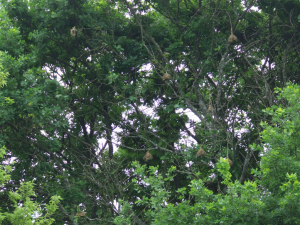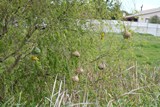PHOWN summaries and recordsVirtual Museum View records in Virtual Museum formatCoverage map for all species Species totals, Nest stats per species and Observer totals Species summary , or General query Observer records, or View VM record Photo of the week, or PHOWN repeats, or PHOWN priorities |
PHOWN record summary
|
Enter new vm record to see a different record and hit 'Go'.
|
Species allocated by Coordinator: Record details entered by participant: (see all records here for this participant) Google map for this record (zoom in and switch to satellite view)
Photos uploaded by observer


Large photos
797, Village Weaver Ploceus cucullatus (see species summary here)Record status ACCEPTED Vm 3127 [on-line data upload (2012-10-04): 23040] Species Village Weaver Observer(s) Clulow David Country, town, locus South Africa, KwaZulu-Natal, Boston,
2930CALocality The Willows, smallholding Latitude, longitude -29.6687627180371, 30.0123846530914 [0 m accuracy] Date 2012/10/4 Notes There have been some changes in the Oak as far as nests are concerned. Whether this is wind damage or female selection, I do not know. Two nests that were built at the top of the Oak have gone plus some others I cannot pinpoint.
There are 9 remaining nests (out of 13 last time) plus a smaller nest which I have not included plus a started nest at the top of the tree, which has been abandoned so far. There are two photos in which some nests are shown twice. Two other nests do not appear at all in the photos, one to the left and the other lower down behind foliage
Nest count 9 Nest site tree
To see this map with all other PHOWN records, click here. Note that the map on this page will load very slowly and probably will only work if you use Chrome as a browser.
History of repeat colony counts
Note: repeats from the same day are not shown.vm Species code Date Nests Notes 2954 797 23/12/2007 0 3055 797 9/9/2012 2 3056 797 19/9/2012 2 Most of the initial building attempts were destroyed by heavy rainfall and this is the restart 3057 797 24/9/2012 8 There are at present 8 nests in the Oak tree, substantially completed, though the builders continue to work on them busily. 3 others are work in progress at earlier stages
A Southern Boubou was roughly treated by the whole group of builders when it sat on one nest a few times. They all dive-bombed it till it left. An African-Harrier Hawk has flown over low and this does not seem promising for the future success of the chicks. There is a pair of Hadedah Ibises sitting on a nest right in the centre of the building of Village Weaver nests. This does not concern the Village Weavers, as is the case with Doves, Cape Sparrows and an African Hoopoe.
3103 797 1/10/2012 13 There are 13 substantially completed nests as of today. One at the top of the tree disappeared last night. It was a rugged looking nest, and the reason can only be speculated at. Comparatively speaking, there was little breeze even last night. The Village Weavers are still building, making final touches. Two photos are from slightly different positions, attempting to include nests where possible, but Oak tree leaves are now getting in the way of some lower nests. 3127 797 4/10/2012 9 There have been some changes in the Oak as far as nests are concerned. Whether this is wind damage or female selection, I do not know. Two nests that were built at the top of the Oak have gone plus some others I cannot pinpoint.
There are 9 remaining nests (out of 13 last time) plus a smaller nest which I have not included plus a started nest at the top of the tree, which has been abandoned so far. There are two photos in which some nests are shown twice. Two other nests do not appear at all in the photos, one to the left and the other lower down behind foliage
3295 797 15/10/2012 6 The Village Weavers in the Oak tree have had a hard week of it, as the weather has tested the few nests further. It is hard to assess what is going on as not much activity can be seen, though there are plenty of Weavers around our house and garden. There are still 6 nests visible to the eye, but the Oak tree leaves have hidden a lower one, which may or may not have survived. Some of the nests seem to have suffered from the weather and appear to have holes underneath. A female was looking at one nest for a while and then flew away.
No new nests are being built.
3484 797 23/10/2012 5 Five discernable nests are in the photo and they are the only ones visible in the tree today. There are no Weavers visible and the nests seem to be inactive. Yesterday at 14:10 an African Harrier-Hawk flew around this side of the tree briefly then left. Shortly after two male Village Weavers sat at two nests and one Weaver started to demolish one nest from below, then tried to undo the grasses holding the nest to a twig. Each time apeice of grass came loose it was dropped
Today there are no signs of Village Weavers at the nests, two or three of which look intact.
At 09:15 by way of experiment, I tossed some crushed maize onto the driveway (about 50 meters from the Oak tree), and watched for arrivals: there were 6 Doves; numerous Common Waxbills and Red-billed Queleas; male and female Cape Sparrows; two Grey-headed Sparrows; some House Sparrows; and two male Red Bishops, partly in breeding colours; and four female Village Weavers. No male Village Weavers, which is unusual. By 09:30 the only change was that a Cape Weaver had joined the breakfast.

Vm 2954
Vm 3055
Vm 3056
Vm 3057
Vm 3103
Vm 3127
Vm 3295
Vm 3484










